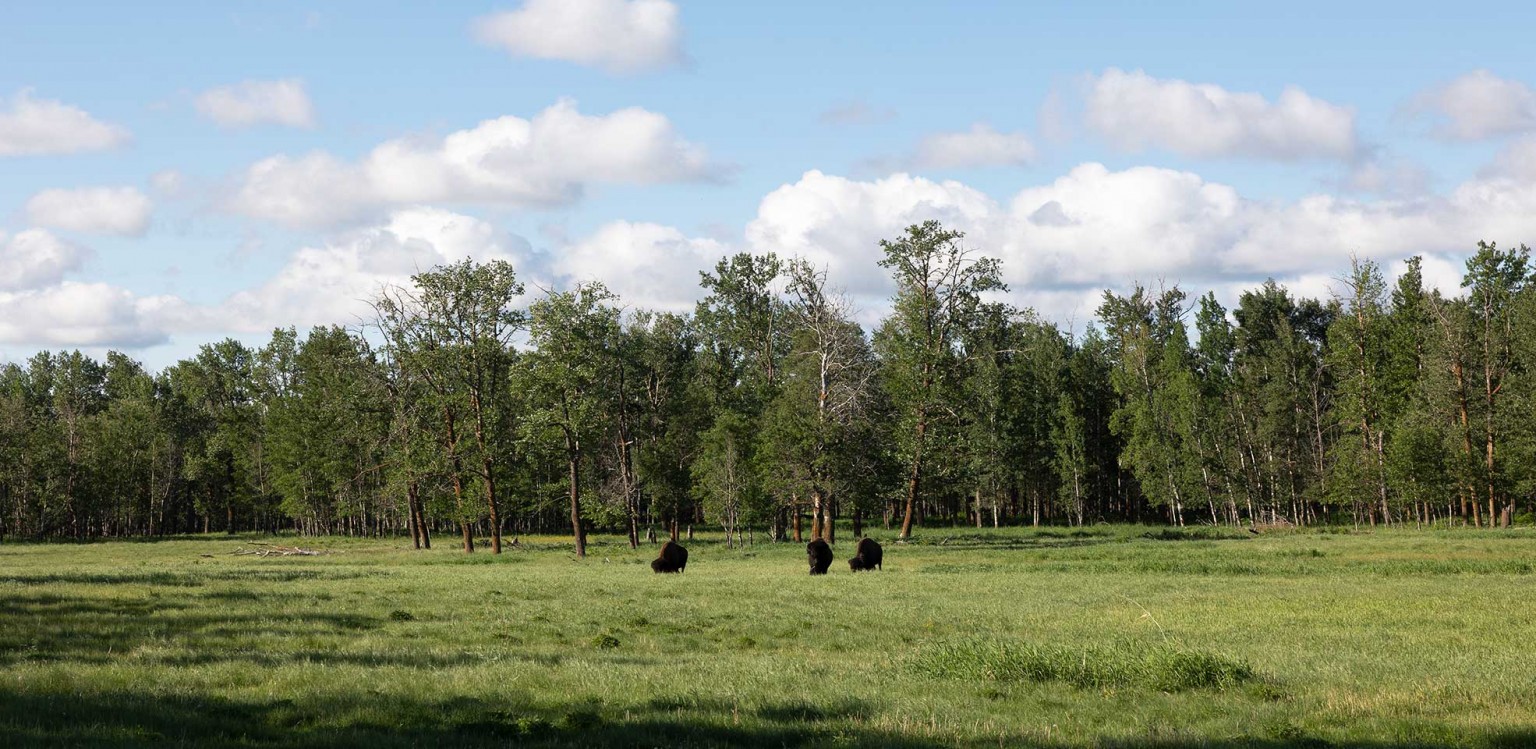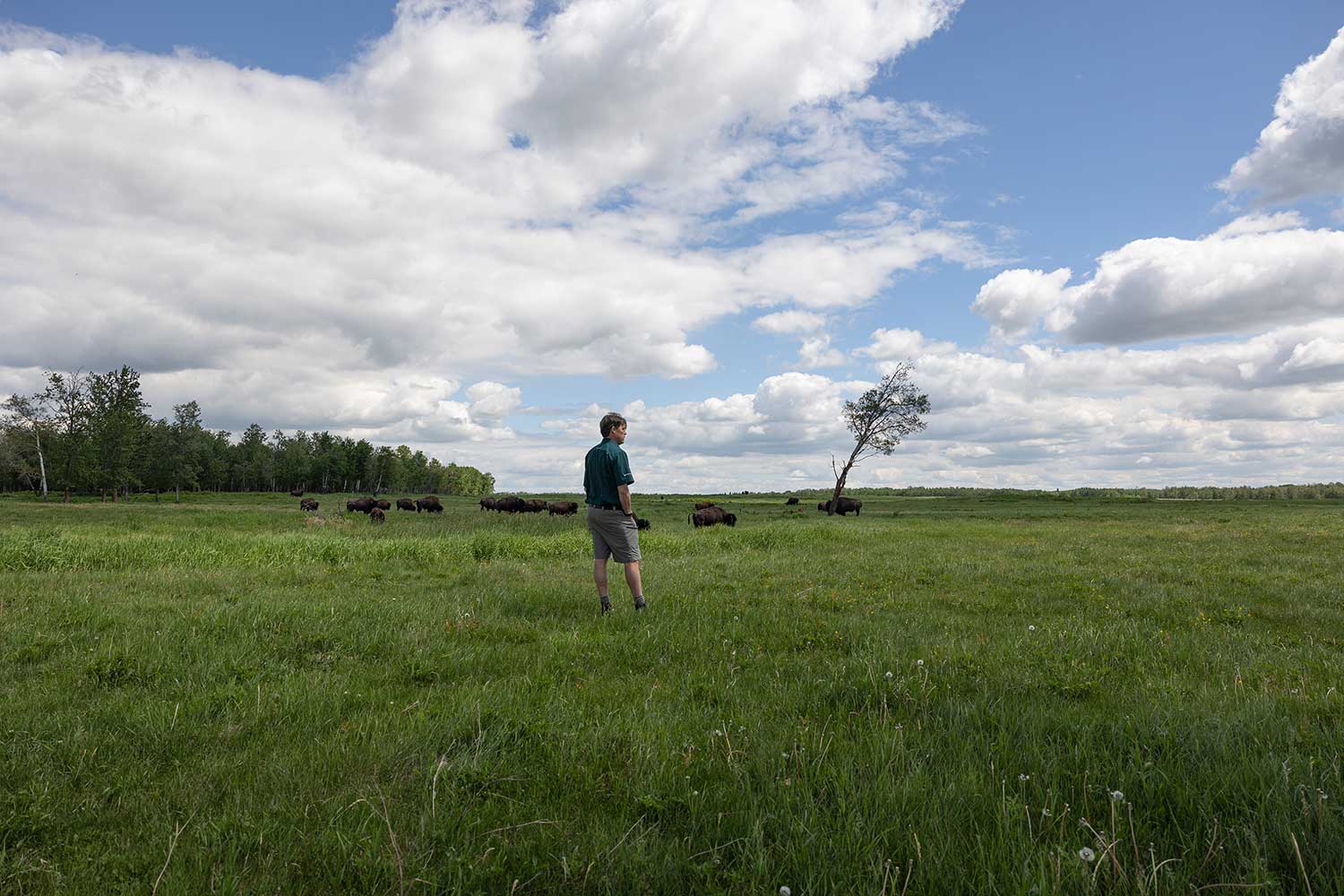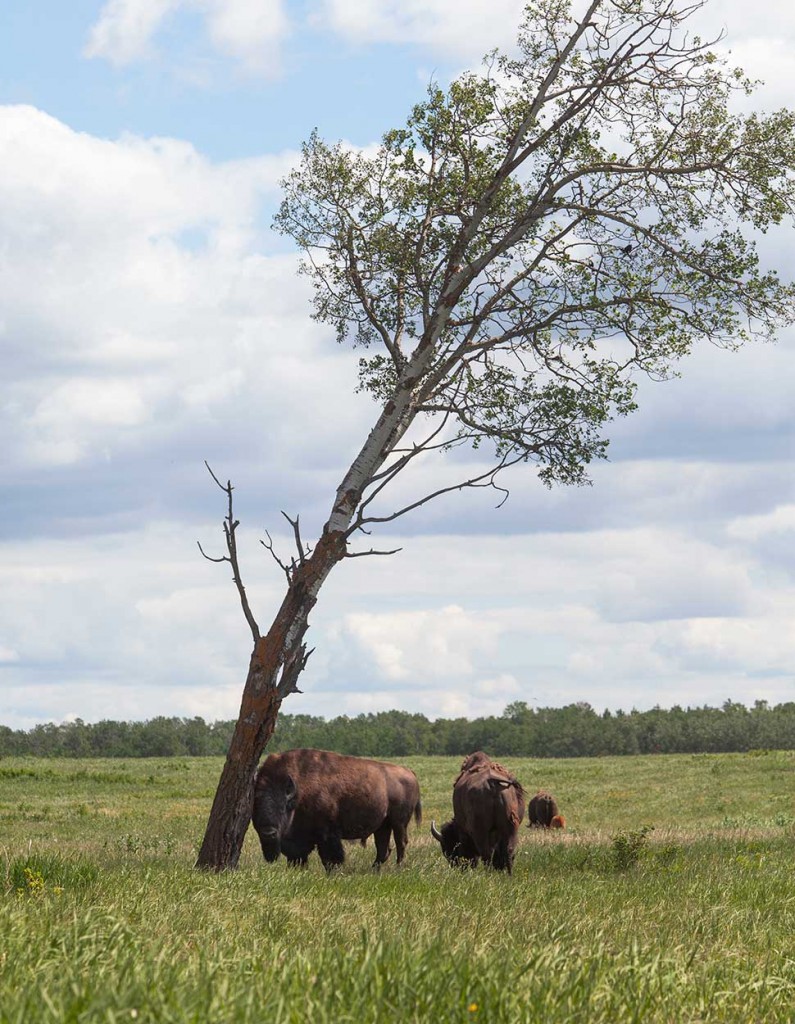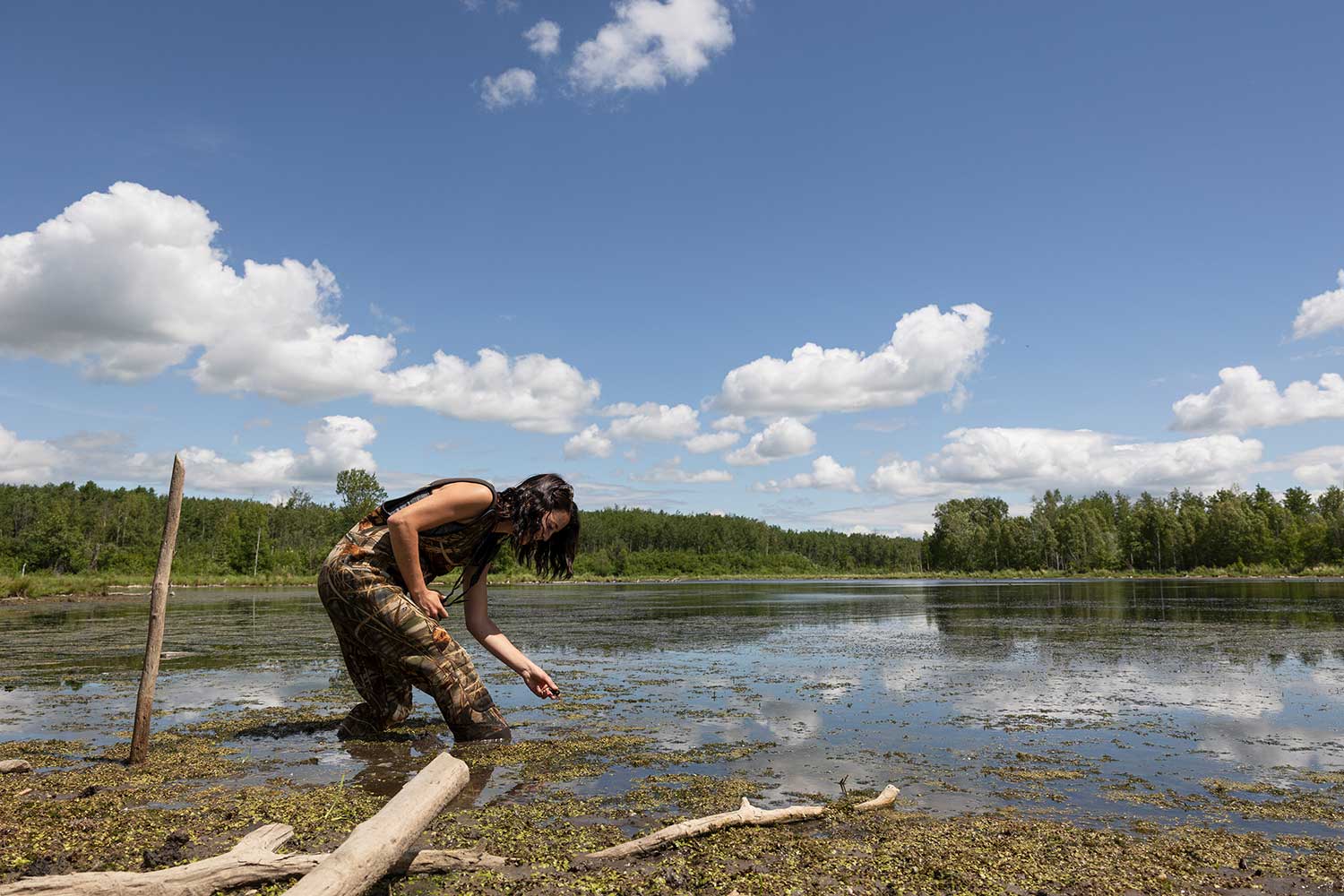Chapter 02

Bison in the Balance
The Beaver Hills Biosphere has a wolf problem: there aren’t enough of them. That’s bad for an ecosystem dominated by bison and elk, who need natural predators to properly fill their vital biological niche. But restoring carnivores to the parks and protecting the world’s most important bison herd means striking a delicate balance between drawing more visitors and minimizing disturbance to the wildlife.
TEXT Matthew Stepanic PHOTOS Ramsey Kunkel
If you were hiking the trails of Cooking Lake-Blackfoot Provincial Park or Elk Island National Park in mid-June of 2021, you may have encountered Cat Fauvelle huddled in the bushes. Along with a team of volunteers, the university researcher spent the better part of the month installing dozens of cameras to track the movements of carnivores and ungulates like elk and bison.
Fauvelle always carries bear spray at her side when she’s working in the parks, but these days, the risk of needing it is low. Local wildlife populations are off balance: there are too many grazers and not enough hunters.
Fauvelle aims to figure out why. Her research poses critical questions about the way that human activity affects fine-tuned ecosystems inside the UNESCO Beaver Hills Biosphere, a specially designated area that encompasses the two parks east of Edmonton, Alberta, as well as farms, residential neighbourhoods, and industrial zones. Have predators reacted negatively to the pandemic-related increase in visitors to the parks? Is neighbouring development disturbing their habitual patterns? Her discoveries will inform the delicate dynamic between the biosphere’s protected areas and the humans who live nearby, as local ecologists strive to invite more participation in the parks while still respecting nature’s limits.

Taking care of where you live
Back in 2001, the leadership at Elk Island National Park grew concerned about the effect that nearby property development was having on its natural ecosystems. The biosphere depends on a healthy buffer zone surrounding the parks, as noise from nearby refineries, farms, or suburbs could disturb the wildlife and force them to move inward, causing overcrowding. Given its proximity to the city of Edmonton, as well as a busy oil and gas hub known as Alberta’s Industrial Heartland, the park needed help defending against too much encroachment.
Local municipalities were the first to respond, prompting the provincial and federal governments to throw in their support as well, along with NGOs and the University of Alberta. Soon, all of these parties were working together to better protect the region, through land-use regulations and educational programs about the intrinsic value of the local ecology. They called it the Beaver Hills Initiative, and in 2016 the area received a UNESCO Biosphere designation.
“It’s a label that’s put on your community that says you must be doing a good job of taking care of where you live,” says Strathcona County Councillor Glen Lawrence.
Lawrence celebrated the announcement by getting a tattoo of the Beaver Hills logo on his arm. “I’m not a piercing or a tattoo guy, but I was born and grew up here, and now when I’m away, I have a little piece of it with me.”
A refuge for bison
Shaped by ancient glaciers, the landscape and ecological features of the Beaver Hills Biosphere shift and change dramatically as you travel through it, from boreal forest to mucky wetlands to rolling grasslands. All that variation has led to “a significantly different suite of critters that live and move through the region,” says Beaver Hills executive director Brian Ilnicki.
Two of the biosphere’s most important denizens are the plains bison and wood bison, which are kept on separate sides of Highway 16 to preserve their genetic purity. A century ago, bison were brought to near extinction by European settlers, and only a small herd of about 45 animals remained in the world. The survivors were brought to Elk Island National Park, and they have thrived there ever since.
The bison are indispensable to maintaining and restoring prairie grasslands, in part through (adorable) behaviours like taking dust baths. By rolling in the dirt to help shed their winter coat or relieve an itch, they aerate the soil, which aids in plant growth and spreads seeds.

Their fur is also ideal for birds’ nests, as its scent masks the eggs from predators. The loose brown tufts shed by the bison have helped foster a healthy songbird population in the biosphere.
They’re also one of the biggest draws for visitors to the park. Fortunate visitors who’ve timed it right will join the line of cars pulled over to watch a herd of bison cross the Bison Loop with calves in tow, or they may encounter an old loner taking a moment to himself on the side of the road. Weighing between 1,500 and 2,500 pounds — perhaps as much as the car you drove to see them — these animals may look fluffy and sedate, but they can be deadly when aggravated.
Creating balance
The bison’s historic brush with extinction has created a false impression that the species remains threatened today, says Jonathan DeMoor, a Parks Canada ecologist who works closely with the bison populations. “It often gets phrased like, ‘We need to protect the bison.’ The problem is they’re doing too well inside of the park. It’s a productive ecosystem, so there’s lots of food for them and a low density of predators.”
The park’s drive to address overpopulation has coincided fruitfully with cultural reclamation efforts by Indigenous peoples across the world. “One of the points of pride about the Elk Island herd is that both populations are free of any cattle gene integration, which makes them ideal candidates to start new herds in other places,” DeMoor says.

Since the program began in 1924, Elk Island has transferred over 2,600 bison to Indigenous communities with strong relationships to the animal, such as the Blackfeet Nation in Montana, who received 87 in 2016.
The handover process takes about a year, to give recipients time to prepare. “It’s about restoring the cultural connection with the communities and restoring the connection of having bison back on their land,” says DeMoor.
Reintroducing carnivores
Although bison are one of the biggest success stories for the biosphere, other animal populations, such as elk, moose, and especially wolves, are just as important. Elk are an easier catch for a wolf, but if they work together in a pack and are patient, they can manage to take down bison, one of North America’s largest land mammals. The park is hoping to rebuild predator populations in order to control the overabundance of bison and other large ungulates like elk, who are able to jump the fence around Elk Island and often return with diseases picked up while visiting neighbouring feedlots.
A higher predator population can help prevent these problems, but so far, that hasn’t panned out. Some unexplained ecological issue is preventing predators from returning to the kind of numbers that are needed. This is where Cat Fauvelle’s research might make the difference.
“Carnivores are really good at recolonizing areas, even after they've been excavated or removed. But they're not really doing that; they're taking a really long time to recolonize in these areas. So we're trying to figure out why.”
— Cat Fauvelle
To monitor the carnivore and ungulate populations, Fauvelle and her team have set up 49 cameras around the biosphere to capture images of passing wildlife and, hopefully, discover what barriers are preventing their movements. Wolves and other carnivores tend to use the path of least resistance, Fauvelle says, and so many of the camera spots can be conveniently placed along walking trails.
The cameras are triggered by motion-detection sensors and are set up to take as many pictures as possible. “I’ll be back in August to do a preliminary sweep of the cameras to see if we’re getting what we want,” says Fauvelle. “In the two months they’re up, I’ll probably have a couple hundred thousand photos to go through.”
Kelsie Norton, who does outreach work for Beaver Hills and helped organize volunteers to assist in the project, says they’re hoping to answer critical questions about the carnivores’ movements: Are the corridors and highways an issue? Are they changing their behaviour around humans? Will the recent increase in visitors affect these trends?




Community-based protection
Fauvelle’s project also caught the interest of people in the surrounding community, Norton says. When the call went out for volunteers to help her set up cameras, eight volunteers signed up immediately, and many more had to be turned away. Volunteers have been integral to the life of the biosphere, whether assisting researchers or turning up for weekend weed pulls. “We build awareness and build opportunities for people who want to get involved in sustaining a unique landscape,” Brian Ilnicki explains.
The park saw record numbers of visitors during the COVID-19 pandemic, but the increased interest in the biosphere isn’t all positive. Visitors can easily add stress to the ecosystem by leaving messes and disturbing the wildlife by getting too close or making a lot of noise. “It’s great to have more people experience the park, but from an ecologist’s perspective, it’s another issue that’s affecting the integrity of the park,” says DeMoor, who acknowledges he’s sometimes tempted “to kick out the people and take down the fences.” But he also knows the importance of direct contact with nature.
“What inspired me to do this work was going to Elk Island as a kid. It’s a part of what Elk Island is doing a great job of: introducing people to the biosphere.”
— Jonathan DeMoor

The long history of conservation in the Beaver Hills Biosphere gives Lawrence hope for its future. “I look back on those people who had the goodwill to preserve those last 45 bison,” he says. “I hope I’m a part of that and that the people coming here will value and protect this area for future generations. Let’s leave this place better than we found it. Let’s prove we value nature, because what we do to nature we do to ourselves.”
To learn more about how the people in the Beaver Hills Biosphere are uniting to keep local ecosystems intact, check out Episode 7 of Striking Balance, a TVO original documentary.
Never Miss Another Issue
Two issues per year
25% OFF previous issues
Free Shipping in Canada


